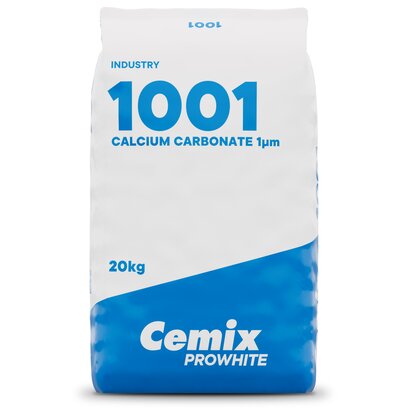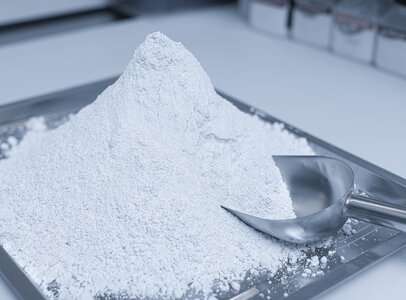1001 CALCIUM CARBONATE 1 MICRON
Technical Advantages
High whiteness and purity: whiteness of 96–98% from premium raw materials ensures a clean and consistent color in final products.
Optimal ultrafine particle size: average size D50 = 1 μm (D98 = 4 μm) improves dispersibility and facilitates incorporation into polymer, coating, and adhesive systems.
Low oil absorption: reduces binder and plasticizer demand, improves processing, increases filler loading, and enhances titanium dioxide efficiency.
High thermal stability: microcalcite particles retain their properties even at elevated processing temperatures, making the filler suitable for plastics and rubber products.
Excellent dispersibility: provides uniform distribution in both water-based and solvent-based systems, which is particularly important for paints, coatings, and adhesives.
Partial TiO₂ replacement: high whiteness and opacity allow optimization of titanium dioxide consumption without loss of hiding power in paints, plastics, and paper formulations.
Functional filler with economic effect: improves mechanical strength and dimensional stability of products while increasing hiding power, filler loading, and durability of coatings, adhesives, and polymers.
Local production and reliable packaging: manufactured in Uzbekistan, ensuring stable supply and reduced logistics costs. Supplied in durable moisture-resistant 25 kg bags, with big-bag packaging available upon request.
Flexible (plasticized) PVC: enhances surface quality (uniformity and smoothness), reduces production cost, and improves mechanical properties.
PVC coatings: increases abrasion resistance, improves surface gloss, and enhances application properties.
Rigid PVC: improves stiffness, extrusion speed, and thermal conductivity of the composite.
Polyurethane systems: increases hardness, improves dimensional stability, and enhances production efficiency.
PVC sheet plastics, molded products, and cable compounds: improves stiffness, strength, and thermal performance.
Polyolefins: enhances molding quality, increases whiteness and surface gloss of final products.
Modern water-based coatings: acts as a functional filler and rheology modifier, improving hiding power and flow properties.
Rubber products: increases tensile strength, stiffness, and abrasion resistance.
| Packed bulk density (ISO 787/11) | 1.0 g/cm³ |
| PH value (ISO 787/9) | 9.5 |
| Oil absorption (ISO 787/5) | 22 g / 100 g |
| Fineness | |
|---|---|
| Residue on a 45 µm sieve (ISO 787/7) | 0.05% |
| Top cut (d98%) | 4 µm |
| Mean particle size (d50%) | 1 µm |
| Particles < 2 µm | 80% |
| Optical properties | |
|---|---|
| Brightness (Ry, C/2º, DIN 53163) | 92.5% |
| Brightness CIE L*, a*, b* (ISO 11664-4) | 96.5/0/0.5 |
| Moisture ex works (ISO 787/2) | 0.2% |
| CaCO3 | 98% |
| MgO | 0.5% |
| Fe2O3 | <0.05% |
| Al2O3 | <0.10% |
| HCL insoluble content | 0.15% |
Explore Product Variant

